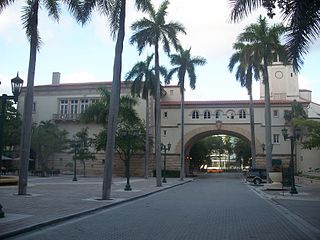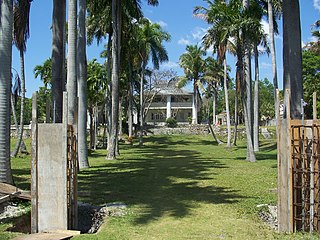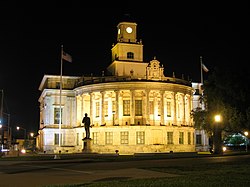
Coral Gables is a city in Miami-Dade County, Florida, United States. The city is part of the Miami metropolitan area of South Florida and is located 7 miles (11 km) southwest of Downtown Miami. As of the 2020 U.S. census, it had a population of 49,248.

The Miami Biltmore Hotel, commonly called TheBiltmore Hotel or The Biltmore, is a luxury hotel in Coral Gables, Florida. The hotel was designed by Schultze and Weaver and built in 1926 by John McEntee Bowman and George Merrick as part of the Biltmore hotel chain. The hotel's tower is inspired by the Giralda, the medieval tower of the cathedral of Seville.

Mediterranean Revival is an architectural style introduced in the United States, Canada, and certain other countries in the 19th century. It incorporated references from Spanish Renaissance, Spanish Colonial, Italian Renaissance, French Colonial, Beaux-Arts, Moorish architecture, and Venetian Gothic architecture.

George Edgar Merrick was a real estate developer who is best known as the planner and builder of the city of Coral Gables, Florida in the 1920s, one of the first major planned communities in the United States.

The Miami Beach Architectural District is a U.S. historic district located in the South Beach neighborhood of Miami Beach, Florida. The area is well known as the district where Italian fashion designer Gianni Versace lived and was assassinated by Andrew Cunanan, in a mansion on Ocean Drive. It is bounded by the Atlantic Ocean to the east, Sixth Street to the south, Alton Road to the west and the Collins Canal and Dade Boulevard to the north. It contains 960 historic buildings.

The MacFarlane Homestead Historic District is a U.S. historic district located in Coral Gables, Florida. The district is bounded by Jefferson Street, Frow Avenue, Brooker Street and Grand Avenue. It contains 32 historic buildings.

The Douglas Entrance is a historic site in Coral Gables, Florida. It is located at the junction of Douglas Road and Tamiami Trail. The architect was Phineas Paist and it was completed in 1924. On September 22, 1972, it is listed on the U.S. National Register of Historic Places.

El Jardin is a house located at 3747 Main Highway in Miami, Florida. It is listed on the U.S. National Register of Historic Places. El Jardin is now home to Carrollton School of the Sacred Heart in Miami, Florida. It was added to the U.S. National Register of Historic Places on August 30, 1974.

Coral Gables Preparatory Academy, formerly Coral Gables Elementary School, is a public K-8 school in Coral Gables, Florida. A part of the Miami-Dade County Public Schools, it has its elementary school classes in the Lower Academy, in the former Coral Gables Elementary building, while the middle school classes are in the Upper Academy at the Merrick Educational Center. The school was given its current name in 2010.

The Neva King Cooper Educational Center is a historic school in Homestead, Florida. It is part of the Miami-Dade County Public Schools district. The school serves students with mental disabilities.

The Coral Gables Police and Fire Station is a historic site in Coral Gables, Florida. Completed in 1939 as a Works Progress Administration project, it was designed by Phineas Paist. In 2003, steps were taken to preserve the building and its legacy and by 2011, it was reopened to the public as the Coral Gables Museum.

The Plymouth Congregational Church is a historic church located at 3429 Devon Road corner of Main Highway in the Coconut Grove in Miami, Florida.

Miami Senior High School, also known as Miami High School, is a public high school located at 2450 SW 1st Street in Miami, Florida, and operated by Miami-Dade County Public Schools. Founded in 1903, it is one of the oldest high schools in Miami-Dade County. The school building is famous for its architecture and is a historic landmark. Miami Senior High School has a rich alumni base, with many graduates of the high school going on to varied, prominent careers. The high school originally served the earliest settling families of Miami in the first half of the 20th century. By the late 1960s, with an increase in Miami's population, its student body grew at a fast pace.

The Trapp Homestead is a historic home in the Coconut Grove section of the City of Miami, Florida, United States. It is located at 2521 South Bayshore Drive. On November 10, 1994, it was added to the U.S. National Register of Historic Places. The home was constructed in 1887 out of oolitic lime quarried locally by Caleb Trapp and his son, Harlan. During construction, the Trapps lived on a thatched hut at the front of the property. The property is believed to be the oldest-standing masonry home in Miami-Dade County, Florida. The estate's construction pre-dates the incorporation of the City of Miami. The estate was particularly notable at the time because it was one of the few stone structures in Miami-Dade County, as nearly all structures in the area were built of wood at that time.
Robert Law Weed (1897–1961) was an architect from Miami, Florida. He designed many Modernist buildings in Miami and abroad.

The David W. Dyer Federal Building and U.S. Courthouse, formerly known simply as the U.S. Post Office and Courthouse, is an historic United States Post Office and federal courthouse of the United States District Court for the Southern District of Florida located at 300 Northeast 1st Avenue in Miami, Florida. Built in 1931 of limestone, it is the largest such structure in South Florida.

Phineas P. Paist was an American architect who was the supervising architect for the Coral Gables Corporation.

The architectural firm of Kiehnel and Elliott was established in Pittsburgh, Pennsylvania, in 1906. The firm did substantial work in Florida, and moved to Miami in 1922. From 1926, it was known as Kiehnel, Elliott and Chalfant.

Walter C. De Garmo (1876–1951) was a prominent architect in Miami, Florida and its surrounding communities. His buildings include the Woman's Club of Coconut Grove and the 1907 Miami City Hall. He is known for his residential work in South Florida, especially large luxury residences in the Mission Revival and Mediterranean Revival styles.

Miami City Hall is the local government headquarters for the City of Miami, Florida. It has been located in the former Pan American Airlines Terminal Building on Dinner Key, which was designed by Delano & Aldrich and constructed in 1934 for the former International Pan American Airport, since 1954. The city's government headquarters originated in Downtown Miami for 58 years until its relocation to Coconut Grove.






















